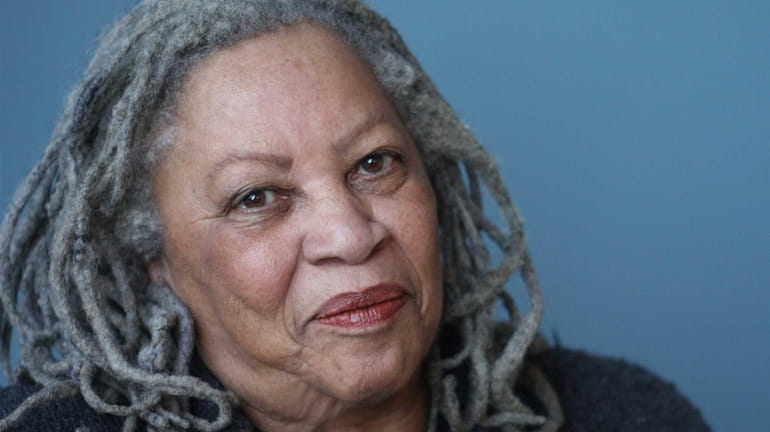Toni Morrison spins a contemporary tale in 'God Help the Child'

Nobel Prize-winning author Toni Morrison has a new novel, "God Bless the Child," out from Knopf in April 2015. Credit: Michael Lionstar
GOD HELP THE CHILD, by Toni Morrison. Alfred A. Knopf, 178 pp., $24.95.
Some 80 years ago, Toni Morrison grew up as Chloe Wofford in a racially mixed, working-class neighborhood in Ohio. So when she arrived at Howard University in Washington, D.C., she was startled, she has said, at the preoccupation with lightness or darkness of skin.
Some of that caste discomfort found its way into Morrison's first masterpiece, "The Bluest Eye," published in 1970 and centered on Pecola Breedlove, an 11-year-old black girl who prays for blue eyes. Now Morrison delivers her first contemporary novel, "God Help the Child," featuring a Jaguar-driving cosmetics executive with "blue black" skin.
Lula Ann Bridewell rebrands herself in southern California as "Bride" -- like Cher or Madonna -- and adopts an all-white wardrobe. "Not only because of your name," a consultant tells her, "but because of what it does to your licorice skin." Bride says, "At first it was boring shopping for white-only clothes until I learned how many shades of white there were: ivory, oyster, alabaster, paper white, snow, cream, ecru, Champagne, ghost, bone."
The author is riffing here on color-consciousness and identity, but because this is Morrison -- America's only living Nobel laureate in literature -- readers know fashion won't be the gist. Indeed, Morrison's 11th novel starts and ends in the voice of Bride's mother, whose deepest mortification comes in birthing a daughter "so black she scared me. Midnight black, Sudanese black. I'm light-skinned, with good hair, what we call high yellow, and so is Lula Ann's father."
Within three years, the marriage craters around this shock. The child grows up within the withering "disdain of her mother and the abandonment of her father." Lula Ann is instructed to call her mother "Sweetness" so as not to embarrass the woman in public. But once the girl is grown and shed of her New York home, she uses the jolt of her Lupita Nyong'o-skin to augment her professional climb. "Black is the new black," says the consultant. "Know what I mean?"
That beautiful jolt also attracts bookish, handsome Booker Starbern, with whom Bride has a scintillating six-month affair. When he abruptly drops her at the start of the story, the reason turns out to be buried in both their pasts. Morrison does an artful job teasing out the subterranean in this short, hypnotic book.
Shoppers selecting "God Help the Child" on Amazon may be surprised to see it categorized as a "Best Seller in Magical Realism." The label probably stems from a fairy tale-like plight Morrison gives Bride: Once Booker bolts, she begins regressing into a girl's body: losing first pubic hair, then armpit hair, then her period, then breasts. Bride's first statement in the novel is "I'm scared. Something bad is happening to me. I feel like I'm melting away."
This fairy-tale vibe is deepened when Bride becomes marooned by a broken foot in a forest cottage with a strange little girl and a benevolent couple who live off the land. Here, Morrison's glints of humor surface. But the august novelist is also returning to old themes of damaged children, haunted adults and monstrous acts. And because the fairy tale is the classic form in which Western culture considers imperiled children, its flavor suits "God Help the Child."
Much of the writing is fine -- vivid and concise -- but the structure of the book is strange, starting with chapter-length first-person narrators, then shifting into the forest interlude, during which Bride thinks, "Without distraction or physical activity, the mind shuffled pointless, scattered recollections around and around."
The novel wobbles in its third part, a long expository telling of Booker's backstory. This section contains a few head-scratchers, such as this romance novel-worthy passage: "Whether he was lying under her body, hovering above it or holding her in his arms, her blackness thrilled him. Then he was certain that he not only held the night, he owned it, and if the night he held in his arms was not enough, he could always see starlight in her eyes."
The novel recovers when it returns to Sweetness, now parked in a New York old folks home, relying on checks from the daughter she long avoided touching. Morrison has a Shakespearean sense of tragedy, and that gift imbues "God Help the Child." The ending is exquisite, bringing to mind Gwendolyn Brooks' wonderful lines: "Art hurts. Art urges voyages -- and it is easier to stay at home."
